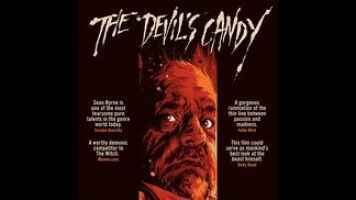Heavy metal and horror movies go together like chocolate and peanut butter, not least because of their shared fascination with Satan. The relationship between the trio goes back to the days when Ozzy Osbourne and his bandmates decided to name Black Sabbath after the Mario Bava movie playing across the street from their rehearsal space, and Australian filmmaker Sean Byrne (The Loved Ones) revisits it once more for his sophomore horror feature, The Devil’s Candy. This time around, though, Byrne adds a twist by appealing to a growing and under-represented segment of the extreme art forms’ shared fan base: parents.
A long-haired, tattooed Ethan Embry stars as Jesse Hellman, a struggling painter who has passed on his love of all things metal to his preteen daughter, Zooey (Kiara Glasco). Along with his wife, loving and tolerant hair stylist Astrid (Shiri Appleby), Jesse just bought a house in the countryside outside of Austin, Texas (where else?), which they got for a bargain thanks to the accidental deaths (or were they?) that took place there not long before. However, the happy alterna-family has also unwittingly placed its youngest member in danger, as the previous owners’ mentally disturbed son, Ray Smile (Pruitt Taylor Vince), is still on the loose and still plagued by demonic voices who tell him to kill children, because “they are his candy.”
Completed in 2015, The Devil’s Candy was screened at festivals as a 90-minute movie, abbreviated to 79 minutes for its theatrical run. And it’s a better film for it, with the new edit foregrounding the film’s core conflict: every parent’s fear that they will one day be unable to protect their children. The festival cut of the film included more comedic in-jokes for the metal fans in the audience, thankfully reduced here to a single, winking visual involving satanic Swedish rockers Ghost; after all, whether or not the parents are into Pantera is irrelevant to the film’s central theme. The new edit also reduces The Devil’s Candy’s major subplot, exploring the relationship between creativity and demonic possession, as Jesse is compelled by forces outside his power to paint morbid tableaus of dead children (actually created by artist Stephen Kasner), which eventually include an unsettling portrait of his daughter in peril.
Ostensibly a haunted-house tale, The Devil’s Candy has, to its credit, very little in terms of stock possession or ghost-movie imagery. Instead, it’s more of a serial-killer thriller, with a dominant aesthetic that’s, well, metal as fuck. The film is bursting with upside-down crosses, flying-V guitars, goats, flames, quick cuts, a blaring soundtrack, and the low, rumbling voices of demons as intoned by drone-metal band Sunn O))). (Without giving too much away, the climactic image could very easily be a metal album cover.) It’s all kind of fun—a fun that’s complicated, presumably intentionally, by the disturbing imagery of Ray violently murdering kids and hacking them up with a hand saw before burying them in suitcases in the Hellmans’ backyard. However, the film moves so quickly that lingering tonal unease from scene to scene never really has time to stick, and little plot questions only start nagging after the last screaming lick over the end credits fades. Given the darkness of its themes, though, it’s probably for the best that this particular riff is played fast and loud.








































![Rob Reiner's son booked for murder amid homicide investigation [Updated]](https://img.pastemagazine.com/wp-content/avuploads/2025/12/15131025/MixCollage-15-Dec-2025-01-10-PM-9121.jpg)
